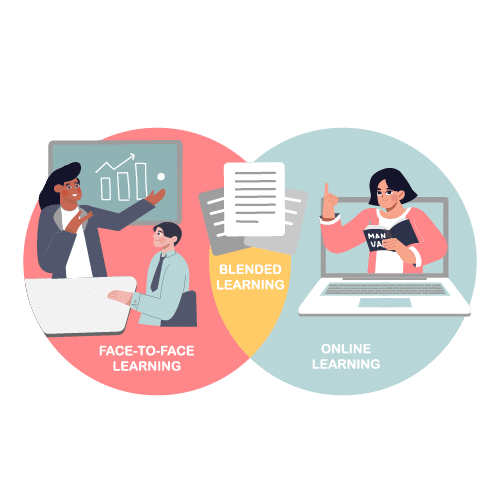What is Blended Learning?
Blended learning, often referred to as hybrid education, revolutionizes the way we learn by seamlessly integrating digital resources and virtual engagement with the conventional in-person classroom experience.
According to the International Society for Technology in Education (ISTE), blended learning, often referred to as hybrid learning, is an instructional approach that combines digital or online learning materials and activities with traditional face-to-face classroom methods.
Online learning offers personalized, self-paced learning with eLearning components that lend themselves to interactive media such as games, videos, tutorials, quizzes and social media components, all accessible from the learner’s home page in the Learning Management System (LMS)—and accessible from the learner’s smartphone or tablet.
Read on to learn more about the benefits of blended learning, blended learning models, best practices, and real-life blended learning examples.
Why Blended Learning?
In the past decade, teachers at higher and lower educational institutions have organically adopted blended learning as a meaningful learning tool in and out of the classroom. Luckily, corporate learning is catching up. The success of blended learning is due to five main benefits:
Blended Learning Models
When you’re teaching a diverse group, it’s almost impossible to tailor the learning experience to suit every learner—or is it? A blended learning model can help you personalize your subject matter for time considerations, learning techniques and even personal preferences, but implementing a blended learning model it requires big changes to how you think about training.
Take a look at some of these blended learning methods and see if they might work for you:
- Face-to-Face: Traditional instructor-led learning sessions supplemented with technology to allow learners to control their own learning pace. Benefits are role-play, mentoring, hands-on practice, and feedback.
- Rotation: Students go from one learning activity to another learning activity, either in a structured learning session directed by a teacher, or online in a self-directed manner. Examples include learning stations, labs, and the flipped classroom where learners practice the lesson before attending the face-to-face training.
- Flex: Flex learning is a term that can be used interchangeably with personalized learning. By accessing means of integration of learning in a Learning Management System (LMS.), the students control their learning path, choosing what they to learn. The instructor is usually present in a mentoring capacity, to answer questions.
- Gamification: One of the most effective ways to motivate learners is by letting them play! By using game play elements such as points or levels, learners feel a little competition and are more motivated to experience the material on their own time.
- Online Lab: This blended learning model is entirely digital, with little or no instructor interaction, and takes place either before, during or after a training. Learners can access content on mobile phones (mLearning), laptops or tablets. This modality engages and solidifies learning.
- Self-Blend: Self-blended learning is supplemental content—either in the form of webinars, white papers, industry blogs, or video tutorials—that help self-motivated learners delve deeper into a subject. A robust LMS can combine diverse content sources under one system to encourage curiosity and growth.
- Online Driver: This blended learning model is entirely self-directed and takes place in a digital environment. Learners can engage with an instructor through chat, email or message board. It provides a flexible schedule and personalized learning, but lacks the face-to-face interaction of other types of blended learning. An LMS is the best way to encourage users to direct their own learning while still monitoring their process as they enjoy media and eventually, engage in classroom discussion. You can choose from existing learning management systems or opt to have an LMS developed specifically for your purposes.
Best Practices for Blended Learning
Blended learning works well for covering a large amount of course material with learners who are independent and engaged. But how can you get learners to take responsibility for their own education? By putting best practices and blended learning strategies to work with the rest of your curriculum, you can make the most of a combined at-home and in-class effort.
1. Explain why you’ve chosen blended learning as your method for delivery
If your learners don’t truly understand the reasoning behind combining both independent and in-class learning, you may lose them from day one. Instead, take the time to explain exactly why you’ve chosen blended learning as your method for delivery. Perhaps you want to respect how your learners learn at different paces—and respect their time; or you would rather spend class time putting concepts to work and engaging in dialog.
2. Include diverse activities
Try to be everything to everyone: While some learners prefer to learn by reading, others get better results by doing. There is no cookie cutter method of effective learning, but including diverse activities such as group discussions, online quizzes, games and even role playing drives user engagement for all learning types.
3. Max Out Media
You and your learners have the most powerful learning tool of all time readily accessible at your fingertips: the internet.
Why write out a whiteboard question when you could show an engaging video? Take this a step further: ask learners to watch a video on their own time, then be prepared to answer discussion questions in class the next day. Why tell your learners a fact when you can have them research at home and report back in class?
Or, try an online module paired with a quick in-class presentation. When learners are given a chance to apply their new knowledge, they increase retention.
Blended learning is effective because learners aren’t just watching or hearing: they’re doing. By applying the new knowledge shortly after they’ve left the physical or virtual classroom, learners retain what they’ve learned, which is a win-win for all.
Blended Learning Examples in Corporate Learning
Check out these real-life examples of blended learning:

When Ticketmaster noticed that their customer service left a lot to be desired, they switched to a blended learning model that combined self-paced custom eLearning with real-world practice that could be observed and assessed for on-the-spot feedback.

Similarly, computer giant CDW found itself lacking when it came to a unified user experience. They made the switch to a synchronous learning platform to allow both in-office and satellite workers the same blended learning resources and tools. Those e-tools were then combined with hands-on experience where learners could practice their skills and become better employees.
Both companies proved that making the switch to a blended learning method means a more customizable experience, but more importantly, a better way for instructors to assess the effectiveness of the module.
How to Get Started with Blended Learning
Take a step back and consider what your training is providing, and what you want the learner to learn. You probably know this already, having developed instructor-led sessions. Using your experience and the help of the instructors, ask yourself: Where are the problems?
Nearly every trainer will tell you there are aspects of their programs that are difficult—both for them and their learners. Think about dry, factual information such as technical specifications, compliance information, or a complicated series of steps that may require practice to master. This is your crack in the door: what can you take out of the instructor-led sessions and develop as eLearning so learners can learn and practice on their own time—and at their own pace?
Contemporary instructional design approaches have developed some really interesting and engaging ways of making that assessment, making eLearning and instructor-led content excellent complements to each other.
Moving some course content to eLearning also benefits the instructor-led sessions, allowing instructors to concentrate more on the application of knowledge or on more complicated tasks. The eLearning can provide the “what” while the instructor-led content can focus on the “how.”
We suggest that you use a system that can track both offline and online training interventions, such as a learning management system that incorporates Tin Can (Experience) API. You can set up such a system to take reports from instructor-led and online learning events equally, and develop a “report card” for each employee to track their learning interventions.
You’re ready to start implementing your own blended learning program! Your learners will thank you for offering learning that works best for them.

